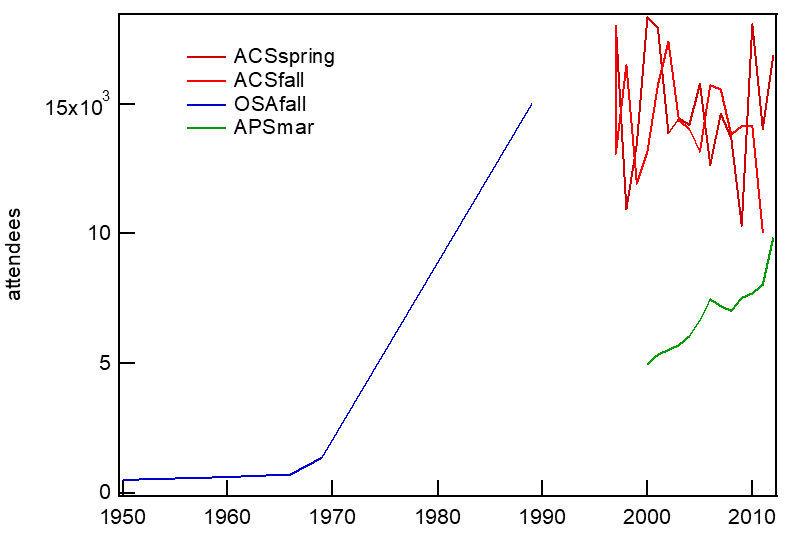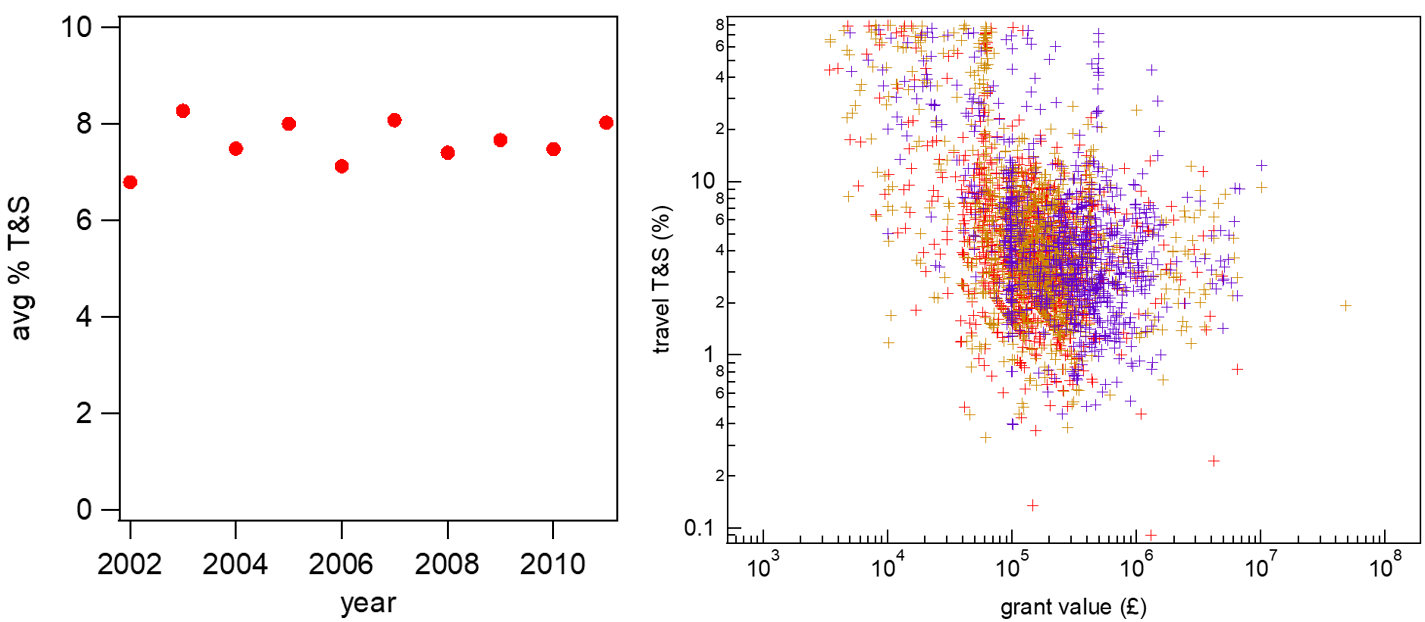- Large conference attendance
It is extremely difficult to find good statistics over long time bases for how many scientists go to international and national conferences. One way is to look at some of the traditional conferences for a field (typically large US-run meetings by learned societies). [data from learned societies]
[data from learned societies]
This shows how difficult it is to collect early data (most of it seems to have been lost), and also that some meetings have morphed, split, or been taken over, so there is not continuity (for instance the Optical Society of America, OSA). While the annual chemistry meetings of the American Chemical Society (two a year, ACS) seem now to be stable, the equivalent American Physical Society meetings (one a year, APS) are still growing, at about the rate of the number of researchers worldwide. The Materials Research Society (MRS) conferences are growing similarly to the APS.
- Travel budgets for scientists
Another way to study the conference component of science, is to look at the amounts scientists spend on travelling. This component has been one of the important parts of the EU science programs for at least the last 30 years, but statistics do not seem to be available. Looking at the UK, the engineering and physical sciences research council (EPSRC) allows grant budgets to be broken down into travel and subsistence which has been a stable 8% of the total grant spend for several decades. Between 2002 (red) and 2010 (purple), this % seems to be stable for the full set of EPSRC UK grants (right graph). However since the average cost of grants has virtually doubled in that time, much more money is being spent on conferences. It is not clear however it this covers more young reseachers paid for on the grants, and they need to travel to conferences, so that the investment of conferences per researcher remains similar. It is likely that this fraction varies in different countries, both due to the cost of travel (eg Austrialia) and the encouragement for scientists to visit other countries (eg South Korea vs USA).
which has been a stable 8% of the total grant spend for several decades. Between 2002 (red) and 2010 (purple), this % seems to be stable for the full set of EPSRC UK grants (right graph). However since the average cost of grants has virtually doubled in that time, much more money is being spent on conferences. It is not clear however it this covers more young reseachers paid for on the grants, and they need to travel to conferences, so that the investment of conferences per researcher remains similar. It is likely that this fraction varies in different countries, both due to the cost of travel (eg Austrialia) and the encouragement for scientists to visit other countries (eg South Korea vs USA).
Many other changes in society may also have impacted how scientists perceive going to conferences. The cost of international travel (particularly in europe and asia) has gone down in the last 20 years, while increased electronic communications keeps scientists in touch more easily with their research teams and adminstrators.
 [data from learned societies]
[data from learned societies] which has been a stable 8% of the total grant spend for several decades. Between 2002 (red) and 2010 (purple), this % seems to be stable for the full set of EPSRC UK grants (right graph). However since the average cost of grants has virtually doubled in that time, much more money is being spent on conferences. It is not clear however it this covers more young reseachers paid for on the grants, and they need to travel to conferences, so that the investment of conferences per researcher remains similar. It is likely that this fraction varies in different countries, both due to the cost of travel (eg Austrialia) and the encouragement for scientists to visit other countries (eg South Korea vs USA).
which has been a stable 8% of the total grant spend for several decades. Between 2002 (red) and 2010 (purple), this % seems to be stable for the full set of EPSRC UK grants (right graph). However since the average cost of grants has virtually doubled in that time, much more money is being spent on conferences. It is not clear however it this covers more young reseachers paid for on the grants, and they need to travel to conferences, so that the investment of conferences per researcher remains similar. It is likely that this fraction varies in different countries, both due to the cost of travel (eg Austrialia) and the encouragement for scientists to visit other countries (eg South Korea vs USA).